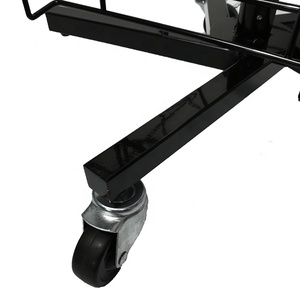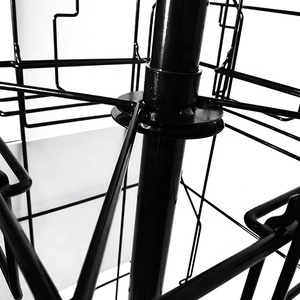(1850 products available)

































































































































































































A deck pedestal system is a foundation support structure for raised decks. The system consists of adjustable pedestals, support beams, and deck tiles. The pedestal system provides a stable, level, and durable foundation for the decking. It is ideal for flat roofs, terraces, and other elevated surfaces.
The deck pedestal system comes in different types. Each type has unique features tailored to specific applications. Here are the most common types:
Adjustable Pedestal System
The adjustable pedestal system is a popular type among contractors and architects. It features a unique height adjustment mechanism. The mechanism allows the user to create a level surface over uneven ground. The system consists of a base, a stem, and a headpiece. Each component serves a specific purpose.
The base is the foundation of the pedestal. It distributes the weight of the deck tiles to the ground. The stem is the vertical part of the pedestal. It supports the headpiece and the deck tiles. The height can be adjusted using screw threads or friction clips. The headpiece is the top part of the pedestal. It supports the joists and deck tiles. The headpieces come in different designs to support various joist configurations.
This system is ideal for supporting terraces, balconies, and roof gardens.
Fixed Height Pedestal
This type of pedestal is not height adjustable. It comes in pre-determined heights. The fixed-height pedestal is less expensive than the adjustable type. It is used in applications where the ground is level. It is also used in situations where the height adjustment is not necessary.
Support beams and tiles are easy to install using a fixed-height pedestal. The system is ideal for residential decks and patios.
Heavy Duty Pedestal
The heavy-duty pedestal is designed to support large and heavy loads. It is made from strong materials like polypropylene and recycled plastics. The materials can withstand harsh environments and weather conditions. This type of pedestal is popular in commercial applications. It is used for supporting large timber or composite decking. The heavy-duty pedestal can support a weight of up to 2,000 pounds. It can also be adjusted to different heights and slopes.
Solar Roof Deck Support
These support pedestals are specially designed for solar panel arrays. They support both solar panels and outdoor spaces like decks or patios. The pedestal system provides easy access to solar panels for maintenance. They also allow for proper drainage and airflow. The solar roof deck support system is ideal for sustainable building designs.
Below are the functions and features of the deck pedestal system:
Height adjustability
Adjustable pedestal for decking enables the construction of terraces and walkways at different elevations. They can raise up to 1.6m, allowing the creation of raised timber patios or cool floating decks. These height-adjustable pedestals can also be stacked to achieve a higher elevation.
Slopes and drainage
Some decking pedestals have inbuilt slope adapters that help create a gentle slope on the deck. They help drain water towards the edges and prevent pooling. The drainage gaps between the boards also facilitate airflow and avoid moisture buildup.
Material support
Decking pedestals support various decking materials, including timber, composite, and porcelain. They allow the use of different decking materials by offering adapters and support bars that secure the boards in place. The system can also accommodate timber of different widths and thicknesses.
Robust structure
These pedestals are usually made of high-quality materials like recycled polypropylene or aluminum. These materials are resistant to weather elements, corrosion, and UV rays. They provide long-term support and stability to the deck.
Easy installation
The pedestal system provides a simple deck construction process. Most of the systems are screw-based, enabling quick assembly without prior experience. They reduce installation time and increase the deck's stability and durability.
Ventilation and access
These systems create gaps between the decking boards for air circulation. The airflow helps regulate temperature and prevent moisture and mold growth. The gaps also provide easy access to the underside of the deck for maintenance and drainage.
Load-bearing capacity
The deck pedestal system can support substantial weight. For instance, a single pedestal can support up to 1,000 kgs. The system distributes the weight evenly across the support points, providing a stable and durable foundation for the deck.
The deck pedestal system is a versatile solution for supporting elevated decking in various applications. Here are some common usage scenarios:
Balconies and Terraces
Balconies and terraces, especially in urban settings, are ideal candidates for pedestal-supported decking. These areas benefit from the quick installation and adjustability of the pedestal system. The ability to create a level surface without heavy machinery or extensive labour is particularly valuable in space-constrained environments.
Rooftop Decks
Deck pedestals are often used in rooftop applications, such as creating outdoor spaces on top of commercial or residential buildings. The adjustable pedestals allow for proper drainage and ventilation while supporting a level and stable decking surface.
Parking Garages
Pedestal decking can transform underutilized spaces like parking garages into functional outdoor areas. For example, using a pedestal system can create green spaces, seating areas, or recreational spaces on top of parking structures while ensuring proper drainage and support.
Pool Decks
A pedestal system can create a raised decking area around a swimming pool. This application allows for water to be easily drained from the deck and underneath the deck boards. The adjustable heights can create a tiered seating area or shaded spot away from the water.
Commercial Spaces
Some commercial spaces, such as cafes or restaurants with outdoor seating, may utilize a pedestal deck system. This setup can quickly install a raised patio for tables and chairs, providing a pleasant dining environment.
Environmental Remediation Projects
In environmental remediation projects, a pedestal deck system may be employed to create temporary or permanent structures above contaminated soil or sensitive areas. The raised platform provides a safe space for activities while minimizing ground disturbances.
Event Spaces
Raised decking supported by pedestals can create tiered seating areas or elevated platforms for speakers and performers. The adaptability of the system allows for custom configurations to suit event requirements.
Residential Applications
Deck pedestals are commonly used in residential settings, such as patios, porches, and poolside lounges. These systems are easy to install, providing homeowners with cost-effective solutions for creating level and stable decking surfaces.
When opting for a deck pedestal system, it is important to consider a few factors. The durability of the materials is important, as well as their adjustability and load-bearing capacity.
The ease of installation and maintenance is also important, as is the price. A warranty can also be a plus when choosing the right product. Consider the durability of the materials. Look for deck pedestals made from high-quality, weather-resistant materials like polypropylene or reinforced plastic. These materials are known for their strength and stability and will ensure that the deck last for a long time.
It is important to check the adjustability of the deck pedestal system. Look for adjustable deck pedestals that allow for precise leveling and alignment of the tiles or planks. The adjustability will compensate for any uneven surfaces and create a flat and stable deck.
Load-bearing capacity is another important factor to consider when choosing a deck pedestal system. Each deck pedestal can support a certain amount of weight. Ensure the chosen pedestal can support the weight of the deck and any additional weight, such as people and furniture.
Installation and maintenance are also important factors. Look for deck pedestals that are easy to install and require minimal maintenance. Features like built-in slope and drainage holes will make installation easier and maintenance simpler.
Pricing is also an important factor to consider when choosing a product. While it may be tempting to go for the cheapest option available, it is important to find a balance between price and quality. A more expensive product may have more features and last longer, so it is worth considering.
Warranties are also important when choosing a product. Look for deck pedestal systems that come with a warranty. This will give peace of mind, knowing that any issues that arise will be taken care of.
Q1: What materials are deck pedestals made of?
A1: Most deck pedestal systems are made of high-quality polypropylene, which is durable and weather-resistant. Other materials include aluminum for lightweight and strong support and rubber for anti-slip and waterproof features.
Q2: Can a deck pedestal support a roof terrace?
A2: Yes, a deck pedestal can support a roof terrace. However, it is important to use a strong and adjustable pedestal to support the weight of the roof terrace. The KORDS adjustable pedestal is a perfect choice for this application. It can carry up to 1,000 kg and can be adjusted to 1.2m.
Q3: What is the maximum height of a deck pedestal?
A3: The maximum height of a deck pedestal depends on the type and brand. For standard height pedestals, they can reach up to 60cm. These include the KORDS standard height deck pedestal. But there are extra height pedestals that can reach up to 120cm. They include the KORDS adjustable height deck pedestal. The maximum height for a pedestal support is 120cm.
Q4: Can deck pedestals be used on sloped surfaces?
A4: Yes, deck pedestals are designed to accommodate sloped surfaces. They are adjustable, allowing for the leveling of the deck surface on uneven ground.
Q5: How do you ensure proper water drainage with a pedestal-supported deck?
A5: To ensure proper water drainage, install the pedestals in a way that allows the deck tiles or planks to be slightly inclined. This promotes water flow toward drainage points. Also, leave gaps between deck boards for optimal water flow and drainage.